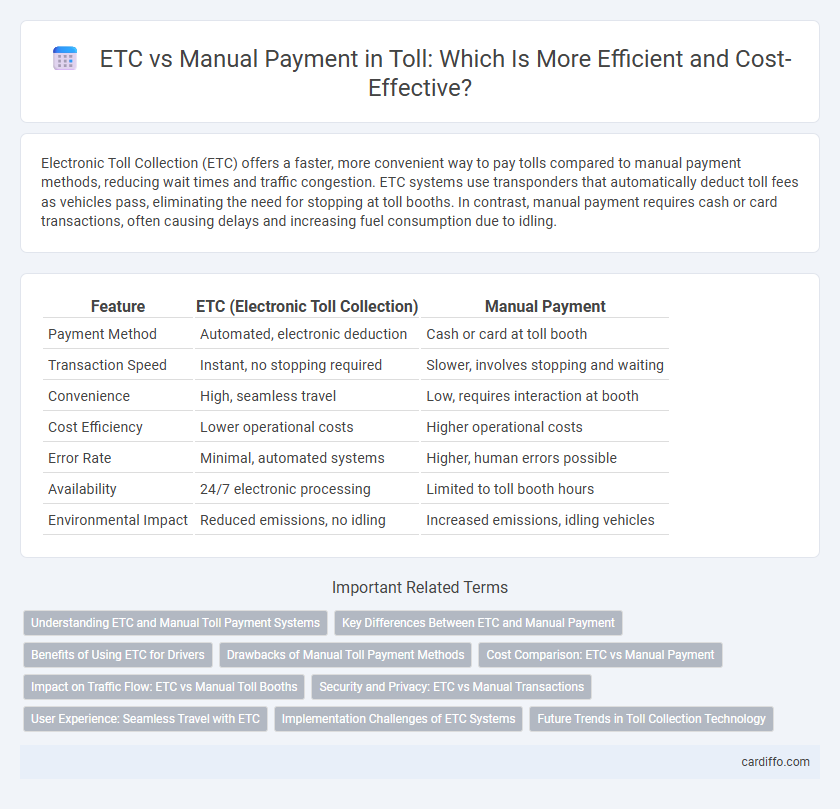Electronic Toll Collection (ETC) offers a faster, more convenient way to pay tolls compared to manual payment methods, reducing wait times and traffic congestion. ETC systems use transponders that automatically deduct toll fees as vehicles pass, eliminating the need for stopping at toll booths. In contrast, manual payment requires cash or card transactions, often causing delays and increasing fuel consumption due to idling.
Table of Comparison
| Feature | ETC (Electronic Toll Collection) | Manual Payment |
|---|---|---|
| Payment Method | Automated, electronic deduction | Cash or card at toll booth |
| Transaction Speed | Instant, no stopping required | Slower, involves stopping and waiting |
| Convenience | High, seamless travel | Low, requires interaction at booth |
| Cost Efficiency | Lower operational costs | Higher operational costs |
| Error Rate | Minimal, automated systems | Higher, human errors possible |
| Availability | 24/7 electronic processing | Limited to toll booth hours |
| Environmental Impact | Reduced emissions, no idling | Increased emissions, idling vehicles |
Understanding ETC and Manual Toll Payment Systems
Electronic Toll Collection (ETC) systems use RFID or license plate recognition technology to automatically deduct toll fees, reducing congestion and improving traffic flow on highways. Manual toll payments require drivers to stop at toll booths to pay with cash or card, often causing delays and increased fuel consumption. The shift towards ETC enhances efficiency and accuracy, benefiting both toll operators and commuters.
Key Differences Between ETC and Manual Payment
ETC (Electronic Toll Collection) enables automatic toll payment using transponders or license plate recognition, eliminating the need to stop at toll booths, thereby reducing congestion. Manual payment requires stopping to pay cash or use credit/debit cards at toll plazas, which often causes delays and longer waiting times. ETC systems also offer streamlined billing and lower transaction costs compared to manual toll collection methods.
Benefits of Using ETC for Drivers
ETC (Electronic Toll Collection) enables drivers to pass through toll plazas without stopping, significantly reducing travel time and congestion. It offers seamless payment through prepaid accounts or linked credit cards, eliminating the need for cash handling and improving convenience. Enhanced accuracy in toll charges and reduced environmental impact from idling vehicles further benefit drivers choosing ETC over manual payment.
Drawbacks of Manual Toll Payment Methods
Manual toll payment methods often result in longer wait times due to cash handling and slower transaction processing at toll booths, causing significant traffic congestion. These methods increase the risk of human error and cash theft, leading to potential revenue losses and inefficiencies. Unlike electronic toll collection (ETC), manual payments do not support seamless, contactless transactions or data-driven traffic management, limiting operational effectiveness.
Cost Comparison: ETC vs Manual Payment
ETC (Electronic Toll Collection) offers a significant cost advantage over manual toll payment through reduced labor expenses and faster transaction times, which minimize vehicle idling and fuel consumption. Manual payment systems incur higher operational costs due to staffing requirements and increased traffic congestion, leading to economic inefficiencies. Implementation of ETC technology results in lower toll processing fees, enhanced throughput, and overall cost savings for both operators and drivers.
Impact on Traffic Flow: ETC vs Manual Toll Booths
Electronic Toll Collection (ETC) systems significantly improve traffic flow by enabling vehicles to pass through toll points without stopping, reducing congestion and wait times compared to manual toll booths. Manual toll booths require vehicles to halt for payment, causing delays and creating bottlenecks, especially during peak travel periods. Implementation of ETC can increase lane throughput by up to 300%, leading to smoother traffic and decreased emissions from idling vehicles.
Security and Privacy: ETC vs Manual Transactions
Electronic Toll Collection (ETC) systems enhance security by minimizing physical contact and reducing the risk of cash theft or fraud compared to manual payment methods. ETC transactions use encrypted data transmission, ensuring greater privacy and protection of vehicle and payment information. Manual payments, involving cash or credit card exchanges, expose users to potential data breaches and theft risks due to handling and processing vulnerabilities.
User Experience: Seamless Travel with ETC
ETC systems offer a seamless travel experience by eliminating the need to stop at toll booths, reducing congestion and saving time for drivers. Manual payment requires vehicles to slow down or stop, leading to longer wait times and increased traffic delays. The convenience of ETC enhances user satisfaction by enabling smooth, uninterrupted journeys on toll roads.
Implementation Challenges of ETC Systems
ETC systems face significant implementation challenges, including high infrastructure costs and the integration of advanced sensor technology for accurate vehicle detection and identification. Ensuring interoperability between different regional and national ETC networks complicates deployment and increases complexity. Data security and privacy concerns present ongoing risks that require robust encryption and compliance measures to protect user information.
Future Trends in Toll Collection Technology
Electronic Toll Collection (ETC) systems are rapidly advancing with smart sensors, AI integration, and blockchain for enhanced accuracy and security, outpacing traditional manual payment methods. Future trends emphasize seamless, contactless transactions via license plate recognition and mobile apps, reducing congestion and improving traffic flow. Data analytics and IoT-enabled infrastructure will further optimize toll pricing and maintenance scheduling, making ETC the preferred choice for efficient and sustainable toll management.
ETC vs Manual Payment Infographic

 cardiffo.com
cardiffo.com